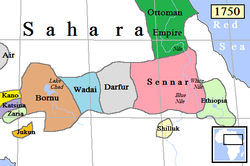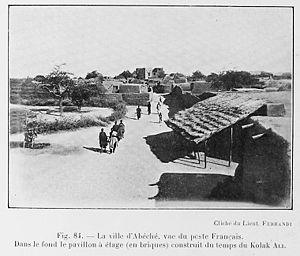- Ouaddai Empire
-
Ouaddai Empire ← 
1635–1909  →
→Ouaddai and surrounding states in 1750. Capital Abeche Language(s) Maban Religion Islam (official 1635) Government Monarchy Kolak - 1603-1637 Abd al-Karim - 1902-1909 Muhammad Doud Mourrah Historical era Early Modern Period - Established 1635 - Disestablished 1909 The Ouaddai Empire (1635–1912) (Also Wadai Empire) was originally a non-Muslim kingdom, located to the east of Lake Chad in present-day Chad. It emerged in the sixteenth century as an offshoot of the Sultanate of Darfur (in present-day Sudan) to the northeast of the Kingdom of Baguirmi.
Contents
Origins
In 1635, the Maba and other small groups in the region rallied to the Islamic banner of Abd al-Karim[disambiguation needed
 ], who led an invasion from the east and overthrew the ruling Tunjur group. Abd al-Karim became the first Kolak or Sultan of a dynasty that lasted until the arrival of the French. During much of the 18th century, Ouaddai resisted reincorporation into Darfur.
], who led an invasion from the east and overthrew the ruling Tunjur group. Abd al-Karim became the first Kolak or Sultan of a dynasty that lasted until the arrival of the French. During much of the 18th century, Ouaddai resisted reincorporation into Darfur.Expansion
In about 1800, during the reign of Sabun, the sultanate of Ouaddai began to expand its power as it profited considerably from its strategic position astride the trans-Saharan trade routes. A new trade route north—via Ennedi, Al Kufrah, and Benghazi--was discovered, and Sabun outfitted royal caravans to take advantage of it. He began minting his own coinage and imported chain mail, firearms, and military advisers from North Africa. Sabun's successors were less able than he, and Darfur took advantage of a disputed political succession in 1838 to put its own candidate in power in Wara, the capital of Ouaddai. This tactic backfired, however, when Darfur's choice, Muhammad Sharif, rejected Darfur's meddling and asserted his own authority. In doing so, he gained acceptance from Ouaddai's various factions and went on to become Ouaddai's ablest ruler. Sharif conducted military campaigns as far west as Bornu and eventually established Ouaddai's hegemony over Baguirmi and kingdoms as far away as the Chari River. In Mecca, Sharif had met the founder of the Senussi Islamic brotherhood, a movement that was strong among the inhabitants of Cyrenaica (in present-day Libya) and that was to become a dominant political force and source of resistance to French colonization.
Decline
The militaristic Ouaddai opposed French domination until being overcome on June 6, 1909 with the occupation of the capital Abeche by French troops where a puppet sultan was installed. Resitance continued until the last independent sultan was captured in 1912 bringing the sultanate to an end. It became part of the independent Republic of Chad on that country's independence in 1960. The Ouaddaï Region of modern Chad covers part of the area of the old kingdom. Its chief town is Abéché.
See also
- Rulers of the Ouaddai Kingdom
References
 This article incorporates public domain material from websites or documents of the Library of Congress Country Studies. - Chad
This article incorporates public domain material from websites or documents of the Library of Congress Country Studies. - ChadExternal links
- waddai.org (Arabic)
Sahelian kingdoms History of modern states under the Ottoman Empire Africa Asia Europe Albania · Bosnia and Herzegovina · Bulgaria · Greece · Hungary · Kosovo · Macedonia · Montenegro · SerbiaCategories:- Former monarchies of Africa
- Former countries in Africa
- States and territories established in 1635
- States and territories disestablished in 1909
- Sahelian kingdoms
- History of Chad
- French Equatorial Africa
- Former empires of Africa
- History of Islam
- 17th century in Africa
- 18th century in Africa
Wikimedia Foundation. 2010.



